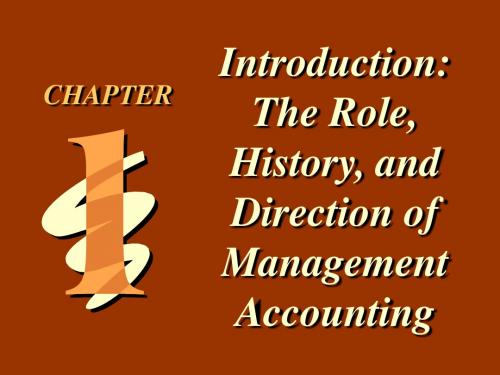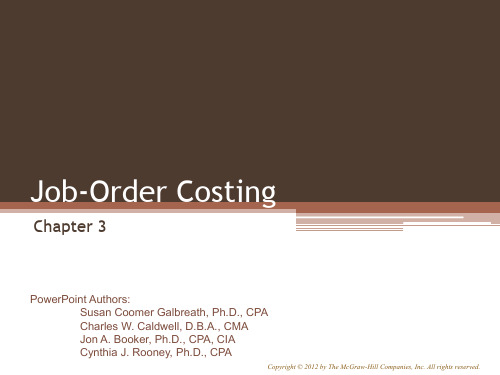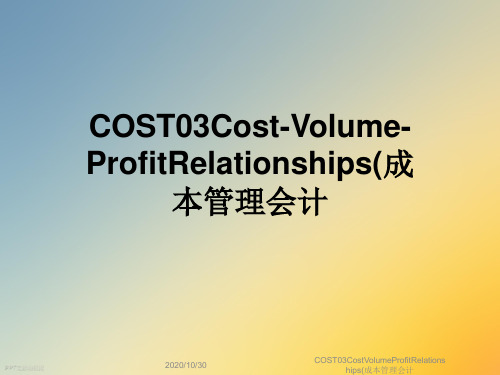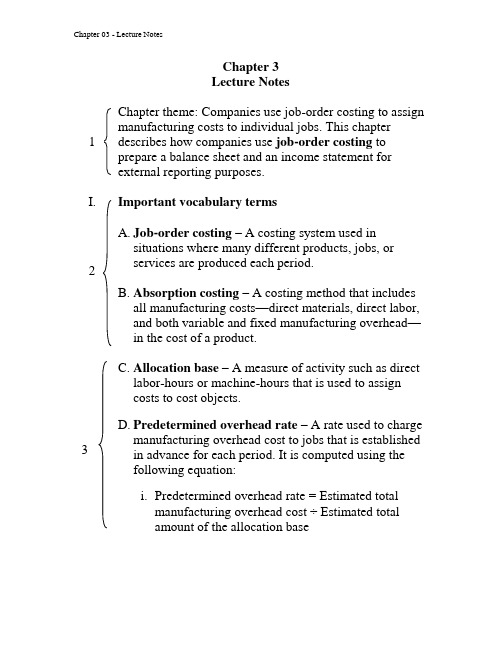管理会计英文版课件ch03
- 格式:ppt
- 大小:363.50 KB
- 文档页数:8






Chapter 3Lecture NotesChapter theme: Companies use job-order costing to assign manufacturing costs to individual jobs. This chapter describes how companies use job-order costing to prepare a balance sheet and an income statement for external reporting purposes.Important vocabulary termsA.Job-order costing– A costing system used insituations where many different products, jobs, orservices are produced each period.B.Absorption costing– A costing method that includesall manufacturing costs—direct materials, direct labor,and both variable and fixed manufacturing overhead—in the cost of a product.C.Allocation base– A measure of activity such as directlabor-hours or machine-hours that is used to assigncosts to cost objects.D.Predetermined overhead rate– A rate used to chargemanufacturing overhead cost to jobs that is establishedin advance for each period. It is computed using thefollowing equation:i.Predetermined overhead rate = Estimated totalmanufacturing overhead cost ÷ Estimated totalamount of the allocation base3E. Overhead application – The process of assigning overhead costs to specific jobs using the following formula:i. Overhead applied to a particular job =Predetermined overhead rate x Amount ofallocation base incurred by the jobF. Normal costing – A costing system in which overhead costs are applied to a job by multiplying apredetermined overhead rate by the actual amount of the allocation base incurred by the job.G. Job cost sheet – A form that records the direct materials, direct labor, and manufacturing overhead cost charged to a job.II.Job-order costing the flow of costsLearning Objectives 1 and 2: Understand the flow of costs in a job-order costing system and prepare appropriate journal entries to record costs. Use T-accounts to show the flow of costs in a job-order costing system.Helpful Hint: Sometimes students need a brief review of journal entries and the use of T-accounts beforebeginning this section of the chapter.A.Key definitionsi.Raw materials– Include any materials that go into the final product.ii.Work in process– Consists of units of production that are only partially complete and will requirefurther work before they are ready for sale tocustomers.iii.Finished goods– Consist of completed units of product that have not yet been sold to customers.iv.Cost of goods manufactured– Includes the manufacturing costs associated with the goods thatwere finished during the period.B.Flow of cost: a conceptual overviewi.Raw materials purchases are recorded in the RawMaterials inventory account.ii.When raw materials are used in production as direct materials, their costs are transferred to theWork in Process inventory account.iii.To transform direct materials into completed jobs, direct labor cost is added to the Work in Processinventory account.iv.Manufacturing overhead cost is applied to Work in Process by multiplying the predeterminedoverhead rate by the actual quantity of theallocation base consumed by each job.v. When jobs are completed , their costs aretransferred from the Work in Process inventoryaccount to the Finished Goods inventory account.vi. The amount transferred from the Work in Processinventory account to the Finished Goods inventory account is referred to as the cost of goodsmanufactured .vii. As goods are sold , their costs are transferred fromthe Finished Goods inventory account to Cost of Goods Sold.viii. Period costs (or selling and administrativeexpenses) do not flow through inventories on the balance sheet. They are recorded as expenses on the income statement in the period incurred.C. Transactions (in T-account and journal entry form) that capture the flow of costs in a job-order costing system are as follows:i. The purchase and issue of materials1. In T-account form :a. The cost of raw material purchases isdebited, and although not shown, the creditside of the transaction would be to AccountsPayable.b. The cost of direct material requisitioned isdebited to Work in Process and added to thejob cost sheets which serve as a subsidiaryledger.c. The cost of indirect material requisitions isdebited to Manufacturing Overhead.a. Debit Raw Materials and credit Accounts Payable.b. Debit Work in Process and Manufacturing Overhead and credit Raw Materials.ii.The recording of labor cost1.In T-account form : a.Direct labor costs are debited to Work in Process and added to the job cost sheetswhich serve as a subsidiary ledger. b. Indirect labor costs are debited to Manufacturing Overhead. 2. In journal entry form : a. Debit Work in Process and Manufacturing Overhead and credit Salaries and Wages Payable. iii.Recording actual manufacturing overhead costs (other than indirect materials and indirect labor) 1. In T-account form : a. As they are incurred, the actual manufacturing overhead costs are debited to Manufacturing Overhead.b. The credit side of the entry is to Cash orvarious liability accounts (e.g., AccountsPayable and Property Taxes Payable),prepaid asset accounts (e.g., PrepaidInsurance), and contra-asset accounts(e.g., Accumulated Depreciation).a. Debit Manufacturing Overhead and credit various accounts as shown.iv. Applying manufacturing overhead costs to workin process1. In T-account form : a. Work in process is debited and Manufacturing Overhead is credited by the amount of the actual quantity of the allocation base multiplied by the predetermined rate . b. Actual manufacturing overhead costs are not debited to Work in Process, nor are they charged to jobs via the job cost sheets. c. The Manufacturing Overhead account is a clearing account . The actual amount of overhead incurred during the period on the debit side of the account will almost certainly not equal the amount applied to Work in Process as shown on the credit side of the account. This requires a year-end adjusting entry that will be discussed shortly.2. In journal entry form : a. Debit Work in Process and creditManufacturing Overhead.Helpful Hint: Students sometimes have difficulty understanding the use of Manufacturing Overhead as a clearing account. Explain that the purpose of the clearing account is to find any discrepancy that exists between the amount of overhead applied to inventory and the amount of overhead actually incurred. Actual overhead incurred is debited to the account. Overhead applied to inventory using the predetermined rate is credited to the account.v.Accounting for nonmanufacturing costsHelpful Hint: Review the concepts of product and period costs at this point. Since period costs are not directly related to the actual manufacture of the products, they are expensed as incurred.panies that use job-order cost systems toassign manufacturing costs to products alsoincur nonmanufacturing costs.2.Nonmanufacturing costs should not go intothe Manufacturing Overhead account.3.Nonmanufacturing costs are not assigned toindividual jobs, rather they are expensed inthe period incurred. For example:a.The salary expenses of employees thatwork in a marketing, selling, oradministrative capacity are expensed inthe period incurred.b.Advertising expenses are expensed in theperiod incurred.vi. Transferring completed jobs from work inprocess to finished goods1. In T-account form : a. The sum of all amounts transferred from work in process to finished goods represents the cost of goods manufactured for the period. b. The Finished Goods Inventory is debited and the Work in Process account is credited.2. In journal entry form : a. Debit Finished Goods and credit Work in Process.vii.Transferring finished goods to cost of goods s old 1. In T-account form : a. Debit Cost of Goods Sold and credit Finished Goods. b. If only a portion of the units associated with a particular job are shipped, then the unit cost figure from the job cost sheet is used to determine the amount of the journal entry. c. This journal entry is also accompanied by a journal entry that recognizes the sales revenue. 2. In journal entry form : a. Debit Accounts Receivable and credit Sales.b. Debit Cost of Goods Sold and creditFinished Goods.Helpful Hint: As a concluding thought, remind studentsthat all inventory accounts are governed by the samelogic: Beginning inventory + Additions = EndingInventory + Transfers out. In the case of raw materials,transfers out consist of both direct and indirectmaterials requisitions. Direct materials requisitions areadded to Work in Process inventory. Indirect materialsrequisitions are debited to Manufacturing Overhead.Additions to Work in Process consist of direct materialsrequisitions, direct labor, and overhead applied.Transfers out of Work in Process consist of coststransferred to Finished Goods. Transfers out ofFinished Goods consist of Cost of Goods Sold.III.Schedules of cost of goods manufactured and cost of goods soldLearning Objective 3: Prepare schedules of cost ofgoods manufactured and cost of goods sold and anincome statement.A.Key conceptsi.This schedule contains three types of costs,namely direct materials, direct labor, andmanufacturing overhead.ii.It calculates the cost of raw material and direct labor used in production and the amount ofmanufacturing overhead applied to production.iii.I t calculates the manufacturing costs associated with goods that were finished during the period.B. Product cost flowsiv. T o create a schedule of cost of goods manufactured, as well as a balance sheet and income statement, it is important to understand the flow of product costs: 1. Raw material purchases made during the period are added to beginning raw materials inventory. The ending raw materials inventory is deducted to arrive at the raw materials used in production . a. As items are removed from raw materials inventory and placed into the production process, they are called direct materials . 2. Direct labor used in production and manufacturing overhead applied to production are added to direct materials to arrive at total manufacturing costs . 3. Total manufacturing costs are added to the beginning work in process to arrive at total work in process . 4. The ending work in process inventory is deducted from the total work in process for the period to arrive at the cost of goods manufactured . 5. The cost of goods manufactured is added to the beginning finished goods inventory to arrive at cost of goods available for sale. The ending finished goods inventory is deducted from this figure to arrive at cost of goods sold . Quick Check product cost flowsIV. Underapplied and overapplied overhead —a closer lookLearning Objective 4: Compute underapplied or overapplied overhead cost and prepare the journal entry to close the balance in Manufacturing Overhead to the appropriate accounts.A. There are two key concepts related to this topic, the first of which is:i. Defining and computing underapplied overheadand overapplied overhead1. The difference between the overhead costapplied to Work in Process and the actualoverhead costs of a period is termed eitherunderapplied overhead or overapplied overhead.a. Underapplied overhead exists when theamount of overhead applied to jobs duringthe period using the predetermined overheadrate is less than the total amount ofoverhead actually incurred during the period.b. Overapplied overhead exists when theamount of overhead applied to jobs duringthe period using the predetermined overheadrate is greater than the total amount ofoverhead actually incurred during the period.Helpful Hint: Students need to understand thatmanufacturing overhead must be estimated at the beginning of the production period. Therefore, theremost likely will be a difference between actual andapplied overhead. A debit balance in the Manufacturing Overhead account indicates more overhead has beenincurred than has been applied to inventory andoverhead is underapplied. A credit balance indicates more overhead has been applied than has beenincurred and overhead is overapplied.puting underapplied or overapplied Array overhead, an example:a.Assume that PearCo’s actual overheadand direct labor hours for the year were$650,000 and 170,000, respectively.b.Recall that PearCo’s total estimatedoverhead and direct labor hours for theyear were $640,000 and 160,000,respectively. Therefore, thepredetermined overhead rate would be $4per direct labor hour.c.The amount of overhead applied to jobsduring the year would be 170,000 directlabor hours × $4 per hour = $680,000.d.In this example, overhead wasoverapplied by $680,000 - $650,000 =$30,000.Quick Check - underapplied overhead and overappliedoverheadii. Disposition of underapplied or overapplied overhead balances1.Any remaining balance in the Manufacturing Overhead account, such as PearCo’s $30,000 of overapplied overhead, is disposed of in one of two ways : a. It can be closed out to Cost of Goods Sold . b. It can be allocated between Work in Process, Finished Goods, and Cost of Goods Sold in proportion to the overhead applied during the current period in the ending balances of these accounts. 2. The journal entry, in T-account form, to close out PearCo’s $30,000 of overapplied overhead into Cost of Goods Sold would be as follows: a. Debit Manufacturing Overhead and credit Cost of Goods Sold. 3. Calculating the allocation of underapplied or overapplied overhead between Work in Process, Finished Goods, and Cost of Goods Sold . a. Assume the overhead applied in Ending Work in Process Inventory, Ending Finished Goods Inventory, and Cost of Goods Sold is $68,000, $204,000, and $408,000, respectively (total value of accounts $680,000). b. In this case, the allocation percentages for Work in Process, Finished Goods, andCost of Goodsc. Sold would be 10%, 30%, and 60%, respectively.d. The allocation of the $30,000 of overapplied overhead would be: Work in Process, $3,000; Finished Goods, $9,000; and Cost of Goods Sold, $18,000. 4. The journal entry to close out the $30,000 of overapplied overhead to each of the three accounts would be: a. Debit Manufacturing Overhead and credit Work in Process, Finished Goods, and Cost of Goods Sold. 5. In summary, there are two methods for disposing of underapplied and overapplied overhead. a. Close out to Cost of Goods Sold. b. Allocate between Work in Process, Finished Goods, and Cost of Goods Sold. c. The latter method is considered more accurate, but it is more complex to compute.Quick Check under- and overapplied overhead。